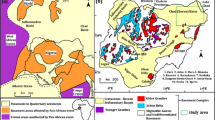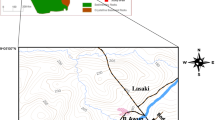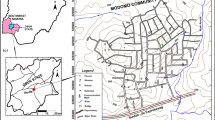Abstract
The present work aims to detect the Phanerozoic sedimentary sub-basins and their hydrocarbon potentialities within the Qattara Ridge in the northern Western Desert, Egypt, through the interpretation of high-resolution land magnetic data. The in-depth relations between observed magnetic anomalies and the magnetic mineralogy of the underlying rocks and the associated chemical reactions are essential to understanding the hydrocarbon potentialities. A high-resolution land magnetic survey has been conducted covering an area of 3600 km2, and several filters have been applied to the measured total field including reduction to pole, normalized source strength, tilt-depth and 3D Euler deconvolution with un-prescribed structural index, to accomplish the goals. Regularized focused inversion was applied to six selected profiles on the total magnetic intensity field to model variations in subsurface magnetic susceptibilities and to study the relation with hydrocarbon reservoirs in the area. Results show perfect structurally controlled sub-basins, with variable thickness of the sedimentary cover ranges for the Paleozoic to Miocene units. The depth of the top basement rocks ranges from 1500 to 7000 m. The calculated depths to the edges from magnetic analysis ranges from 292 to 3322 m. Some faults can be detected at 3900 m, and five possible sedimentary basins (depocenters) can be detected within the Qattara Ridge, trending NW–SE and N–S. Magnetic results also show that the central part of Qattara Ridge is affected by low magnetic anomaly, and many magnetization sources can be detected in the northern directions. The common trend in these sources is NW–SE. Most shallow depth to magnetic sources is concentrated at the northern part of the area, while the deeper sources are distributed in the west and south of the study area. The maximum depth recorded is about 3988 m. Inversion shows remarkable relations between the inverted magnetic susceptibilities and the different hydrocarbon productive and sealing zones in and close to the study area. The localized variations in the inverted anomalous magnetic susceptibilities in the Qattara Ridge were possibly produced by different intrasedimentary mineral magnetic phases developed near the surface due to hydrocarbon occurrences. Reducing gases, coming from the possible underlying hydrocarbon reservoir, play a critical role in the formation of these secondary magnetic minerals. The reservoir in the Qattara Ridge, based on the present study, is characterized by low magnetic susceptibility and low surface magnetic anomaly in the studied locations of productive wells. The interpretations show matching between the sedimentary thickness and position of the faults deduced from both the available drilled wells and seismic data with our magnetic results.
















Similar content being viewed by others
References
Abdelazeem, M. (2019). Implementation of the geosciences to construct the new Desert Urban, site management, and distribute resources. Pilot area: Moghra Oasis, Qattara Depression. Unpublished internal report, STDF, No. 15239.
Abdelazeem, M., El-Sawy, K. E., & Gobashy, M. M. (2013). Analysis of magnetic gradients at North East of Wadi Ar Rika quadrangle, Saudi Arabia, to delineate subsurface linear features and faults. NRIAG Journal of Astronomy and Geophysics, 2(1), 27–38.
Abdelazeem, M., Mekkawi, M., & Gobashy, M. (2014). Subsurface structures using a new integrated geophysical analysis, South Aswan, Egypt. Arabian Journal of Geosciences, 7, 5141–5157.
Abdelazeem, M., Salem, Z. E., Fathy, M. S., & Saleh, M. (2020). Impact of lithofacies and structural setting on the hydrogeochemistry of the lower Miocene aquifer at Moghra Oasis, North Western Desert, Egypt. Natural Resources Research. https://doi.org/10.1007/s11053-020-9679-3.
Abubakar, R., Muxworthy, A. R., Sephton, M. A., Southern, P., Watson, J. S., Fraser, A. J., et al. (2015). Formation of magnetic minerals at hydrocarbon-generation conditions. Marine and Petroleum Geology. https://doi.org/10.1016/j.marpetgeo.2015.10.003.
Ammar, A. A., Meleik, M. L., & Fouad, K. M. (1983). Tectonic analysis of a sample area, Central Eastern Desert, Egypt, applying aeroradiometric and aeromagnetic survey data. Bulletin Faculty of Earth Sciences, King Abdulaziz Univ Jeddah, Kingdom of Saudi Arabia, 6, 459–482.
Bakr, M. (2009). Molecular organic geochemistry of crude oil from Shushan and Abu Gharadig Basins, Western Desert, Egypt. Earth Sciences, 20, 97–125.
Baranov, V. (1957). A new method for interpretation of aeromagnetic maps pseudo gavimetric anomalies. Geophysics, 22, 359–383.
Baranov, V., & Naudy, H. (1964). Numerical calculation of the formula of reduction to the magnetic pole. Geophysics, 29, 67–79.
Beiki, M., Clark, D. A., Austin, J. R., & Foss, C. A. (2012). Estimating source location using normalized magnetic source strength calculated from magnetic gradient tensor data. Geophysics, 77, J23–J37.
Benthien, R. H., & Elmore, R. D. (1987). Origin of magnetization in the phosphoria formation at Sheep Mountain: Wyoming: A possible relationship with hydrocarbon. Geophysical Research Letters, 14, 323–326.
Bevan, T. G., & Moustafa, A. (2012). Inverted rift-basins of northern Egypt. Regional Geology and Tectonics Phanerozoic Rift Systems and Sedimentary Basins. https://doi.org/10.1016/B978-0-444-56356-9.00018-3.
Bosworth, W., El-Hawat, A., Helgeson, D., & Burke, K. (2008). Cyrenaican “shock absorber” and associated inversion strain shadow in the collision zone of northeast Africa. Geology, 36(9), 695–698.
Bosworth, W., Stockli, D. F., & Helgeson, D. E. (2015). Integrated outcrop, 3D seismic, and geochronologic interpretation of Red Sea dike-related deformation in the Western Desert, Egypt—the role of the 23 Ma Cairo ‘‘mini-plume. Journal of African Earth Sciences, 109, 107–119.
Boukhary, M., Nahas, S., Abd El Naby, A., Abdel Aal, M., Mahsoub, M., & Faris, M. (2014). Seismic and sequence stratigraphy of Upper Cretaceous-Tertiary succession, eastern Abu-Gharadig Basin, Western Desert, Egypt. Stratigraphy, 11(2), 109–141.
Clark, D. A. (2012). New methods for interpretation of magnetic vector and gradient tensor data I: Eigenvector analysis and the normalized source strength. Exploration Geophysics, 43, 267–282.
Clark, D. A. (2014). Methods for determining remanent and total magnetisations of magnetic sources—a review. Exploration Geophysics, 45(4), 271.
Costanzo-Alvarez, V., Aldana, M., Dìaz, M., Bayona, G., & Ayala, C. (2006). Hydrocarbon-induced magnetic contrasts in some Venezuelan and Colombian oil wells. Earth Planets Space, 58, 1401–1410.
Dolson, J. C., Shann, M. V., Matbouly, S., Harwood, C., Rashed, R., & Hammouda, H. (2001). The petroleum potential of Egypt, in petroleum provinces of the twenty-first century. AAPG Memoir, 74, 453–482.
EGPC, Egyptian General Petroleum Corporation Stratigraphic Committee. (1964). Oligocene and Miocene rock stratigraphy of the Gulf of Suez region (p. I42). Cairo: EGPC.
EGPC, Egyptian General Petroleum Corporation. (1992). Western desert, oil and gas fields (a comprehensive overview) (p. 431). Kalyoub: Al-Ahram Commercial Presses.
El-Gaby, S., List, F. K., & Tehrani, R. (1988). Geology, evolution and metallogenesis of the Pan African belt in Egypt. In S. El-Gaby & R. O. Greiling (Eds.), The Pan African belt of northeast Africa and adjacent areas (pp. 17–68). Braun-Schweig: Vieweg.
El-Naga M. A. (1984). Palaeozoic and Mesozoic depocentres and hydrocarbon generating areas, Northern Western Desert: E.G.P.C. In: Eleventh exploration and production conference, Cairo, pp. 269–287.
Foote, R. S. (1992). Use of magnetic fields aids in oil search. Oil and Gas Journal, 90, 137–141.
Foote, R. S. (1996). Relationship of near-surface magnetic anomalies to oil and gas-producing areas. In D. Schumacher & M. A. Abrams (Eds.), Hydrocarbon migration and its near-surface expression (Vol. 66, pp. 107–122). Washington: AAPG Memoir.
Garfunkel, Z. (2004). Origin of the Eastern Mediterranean basin: A reevaluation. Tectonophysics, 391, 11–34.
Gerovska, D., & Bravo, M. J. A. (2003). Automatic interpretation of magnetic data based on Euler deconvolution with unprescribed structural index. Computers and Geosciences, 29, 949–960.
Gobashy, M. M. (2006). Analysis of aeromagnetic measurements from the Southern Part of Al Hissu Quadrangle, Saudi Arabia using Euler deconvolution with unpresriped Structural Index. Journal of petroleum and mining engineering, Suez Canal University, 8, 1–37.
Gobashy, M. M., & Al-Garni, M. A. (2008). High resolution Ground Magnetic Survey (HRGM) for determining the optimum location of subsurface dam in Wadi Nu’man, Makkah Al Mukarammah, KSA. Journal of King Abdulaziz University Earth Sciences, 19, 57–83.
Guiraud, R., & Bosworth, W. (1997). Senonian basin inversion and rejuvenation of rifting in Africa and Arabia: Synthesis and implications to platescale tectonics. Tectonophysics, 282, 39–82.
Guiraud, R., Bosworth, W., Thierry, J., & Delplanque, A. (2005). Phanerozoic geological evolution of Northern and Central Africa: An overview. Phanerozoic evolution of Africa. Journal of African Earth Sciences, 43, 83–143.
Gunn, P. J. (1972). Application of Wiener filters to transformations of gravity and magnetic fields. Geophysical Prospecting, 20, 860–871.
Gunn, P. J. (1975). Linear transformations of gravity and magnetic fields. Geophysical Prospecting, 23, 300–312.
Gunn, P. J. (1995). An algorithm for reduction to the pole that works at all magnetic latitudes. Exploration Geophysics, 26, 247–254.
Janssen, M. E., Stephenson, R. A., & Cloetingh, S. (1995). Temporal and spatial correlations between changes in plate motions and the evolution of rifted basins in Africa. Geological Society of America Bulletin, 107, 1317–1332.
Keeley, M. L. (1989). The Palaeozoic hisory of the Western Desert of Egypt. Basin Research, 2, 35–48.
Khan, S. D., Fathy, M. S., & Abdelazeem, M. (2014). Remote sensing and shallow geophysical investigations on Moghra Lake in Northeastern Qattarra Depression, Western Desert, Egypt. Geomorphology, 207, 10–22.
Klitzsch, E. H. (1986). Plate tectonics and cratonal geology in Northeast Africa (Egypt, Sudan). Geologische Rundschau, 75, 755–768.
Kovesi, P. (2020). MATLAB and Octave functions for computer vision and image processing. Retrieved June 7, 2020 from http://www.peterkovesi.com/matlabfns/.
Liu, Q. S., & Liu, S. G. (1999). Magnetic and mineralogical characteristics of reservoir rocks in the Yakela oil field, northern Tarim Basin and their implications for magnetic detection of oil and gas accumulations. Chinese Science Bulletin, 44, 174–177.
Liu, Q. S., Liu, S. G., Qu, Z., Xu, Z. X., & Hou, W. G. (1998b). Magnetic and mineralogical characteristics of hydrocarbon microseepage above oil/gas reservoirs of the Touku region, northern Tarim Basin, China. Science China, 41, 121–129.
Liu, Q. S., Cheng, T. J., & Liu, S. G. (1998a). Comprehensive evaluation of the mechanism of “chimney effect” using principles of magnetic, geochemistry and mineralogy. Chinese Science Bulletin, 43, 743–748.
Liu, Q. S., Chan, L. S., Liu, Q. S., Li, H. X., Wang, F., Zhang, S. X., et al. (2004). Relationship between magnetic anomalies and hydrocarbon microseepage above the Jingbian gas field, Ordos Basin, China. AAPG Bulletin, 88, 241–251.
Maky, A. F., & Ramadan, M. A. (2008). Nature of organic matter, thermal maturation and hydrocarbon potentiality of Khatatba Formation at East Abu-gharadig Basin, North Western Desert, Egypt. Australian Journal of Basic and Applied Sciences, 2(2), 194–209.
Meshref, W.M. (1982). Regional structural setting of northern Egypt. In: 6th E.G.P.C. Exploration Seminar.
Meshref, W. M., & Elsheikh, M. M. (1973). Magnetic tectonic trend analysis in the northern Egypt. Egyptian Journal of Geology, 17(2), 179–184.
Morgan, P. (1990). Egypt in the framework of global tectonics. In R. Said (Ed.), The geology of Egypt (pp. 91–112). Avereeset: Balkema.
Moustafa, A. R. (2008). Mesozoic-Cenozoic basin evolution in the northern Western Desert of Egypt. In M. Salem, A. El-Arnauti, & A. Saleh (Eds.), 3rd Symposium on the sedimentary basins of Libya (The geology of east Libya), Vol. 3, pp. 29–46.
Nabighian, M. N., Ander, M. E., Grauch, V. J. S., Hansen, R. O., La Fehr, T. R., Li, Y., et al. (2005). Historical development of the gravity method in exploration. Geophysics, 70, 63–89.
Perez-Perez, A., D’Onofrio, L., Bosch, M., & Zapata, E. (2011). Association between magnetic susceptibilities and hydrocarbon deposits in the Barinas-Apure Basin, Venezuela. Geophysics, 76(6), L35–L41.
Portniaguine, O., & Zhdanov, M. S. (1999). Focusing geophysical inversion images. Geophysics, 64(3), 874–887.
Rehman, F., Abdelazeem, M., Gobashy, M. M., Harbi, H. M., Rehman, F., & Abuelnaga, H. S. O. (2019). Application of magnetic method to define the structural setting controlling the contaminated area of Wadi Bani Malik, east Jeddah, Saudi Arabia. Bollettino di Geofisica Teorica ed Applicata, 60(1), 97–122.
Reid, A. B. (2003). Euler magnetic structural index of a thin bed fault. Geophysics, 68, 1255–1256. (Published electronically, May 2003).
Said, R. (1962). The geology of Egypt (p. 377). Amsterdam: Elsevier.
Said, R. (1990). The geology of Egypt (p. 370). Amsterdam: Elsevier.
Salem, A., Williams, S., Fairhead, J. D., Ravat, D., & Smith, R. (2007). Tilt-depth method: A simple depth estimation method using first-order magnetic derivatives. Leading Edge, 26, 12.
Salem, A., Williams, S., Fairhead, D., Smith, R., & Ravat, D. (2008). Interpretation of magnetic data using tilt-angle derivatives. Geophysics, 73(1), L1–L10.
Saunders, D. F., & Terry, S. A. (1985). Onshore exploration using the new geochemistry and geomorphology. Oil and Gas Journal, 83, 126–130.
Saunders, D. F., Burson, K. R., Branch, J. F., & Thompson, C. K. (1989). Alabama Ferry field detectable by hydrocarbon microseepages and related alterations. Oil and Gas Journal, 87, 53–55.
Saunders, D. F., Burson, K. R., & Thompson, C. K. (1991). Observed relation of soil magnetic susceptibility and soil gas hydrocarbon analyses to subsurface hydrocarbon accumulations. AAPG Bulletin, 75, 389–408.
Schlumberger, L. (1984). Geology of Egypt. In: Well evaluation conference, Schlumberger Ltd, Egypt, (pp. 1–19).
Sestini, G. (1984). Tectonic and sedimentary history of NE African margin (Egypt/Libya). In J. E. Dixon & A. H. F. Robertson (Eds.), The geological evolution of the eastern Mediterranean (pp. 161–175). Oxford: Blackwell Scientific Publishers.
Shackleton, R. M. (1980). Precambrian tectonics of NE Africa. Bulletin Institute of Applied Geology King Abdul Aziz University, Jeddah, 3(2), 1–6.
Stampfli, G. M., Mosar, J., Favre, P., Pillevuit, A., & Vannay, J. C. (2001). Permo-Mesozoic evolution of the western Tethys realm: The Neo-Tethys East Mediterranean Basin connection. In P. A. Ziegler (Ed.), Peri-Tethys Memoir 6: Peri-Tethyan rift/wrench basins and passive margins (pp. 51–108). Paris: Mémoires du Muséum National d’Histoire Naturelle de Paris.
Thompson, R. J., Stober, C., Turner, G. M., Oldfield, F., Bloemendal, J., Dearing, J. A., & Rummery, T. A. (1980). Environmental applications of magnetic measurements. Science, 207, 481–486.
Tompkins, K. (1990). Direct location technologies: Unified theory. Oil and Gas Journal, 88, 126–134.
Vacquier, V. S., Enland, N. C., Henderson, R. G., & Zietz, I. (1951). Interpretation of aeromagnetic maps (p. 47). Washington: Geological Society of America Memoir.
Wilson, H. (1985). Analysis of the magnetic gradient tensor. Defence Research Establishment Pacific, Canada, Technical Memorandum, 47, 85–13.
Wynn, W. M. (1999). Detection, localization, and characterization of static magnetic-dipole sources. In C. E. Baum (Ed.), Detection and identification of visually obscured targets (pp. 337–374). Philadelphia: Taylor & Francis.
Younes, M. A. (2012). Hydrocarbon potentials in the Northern Western Desert of Egypt. In M. Younes (Ed.), Crude oil exploration in the World. Berlin: In Tech. (ISBN: 978-953-51-0379-0).
Youssef, M. L. (1968). Structural pattern of Egypt and its interpretation. American Association of Petroleum Geologist Bulletin, 52(4), 601–614.
Acknowledgements
The study was funded by the Science and Technology Development Fund (STDF), Egypt [Project ID: 15239]. The authors appreciate so much the great effort from the two anonymous reviewers, which helped us significantly in modifying and developing the manuscript and clarifying our ideas.
Author information
Authors and Affiliations
Corresponding author
Ethics declarations
Conflict of interest
The authors declare that they have no conflict of interest with respect to the research, authorship, and/or publication of this article.
Additional information
Publisher's Note
Springer Nature remains neutral with regard to jurisdictional claims in published maps and institutional affiliations.
Rights and permissions
About this article
Cite this article
Abdelazeem, M., Fathy, M.S. & Gobashy, M. Magnetometric Identification of Sub-basins for Hydrocarbon Potentialities in Qattara Ridge, North Western Desert, Egypt. Pure Appl. Geophys. 178, 995–1020 (2021). https://doi.org/10.1007/s00024-021-02678-2
Received:
Revised:
Accepted:
Published:
Issue Date:
DOI: https://doi.org/10.1007/s00024-021-02678-2




